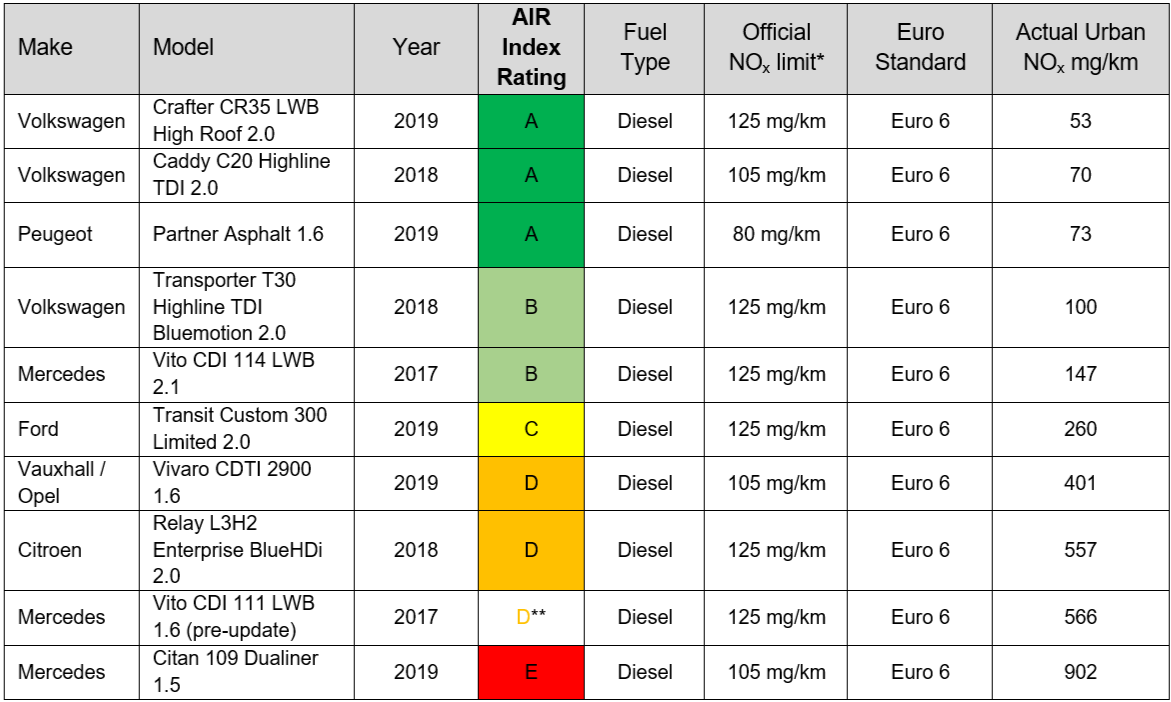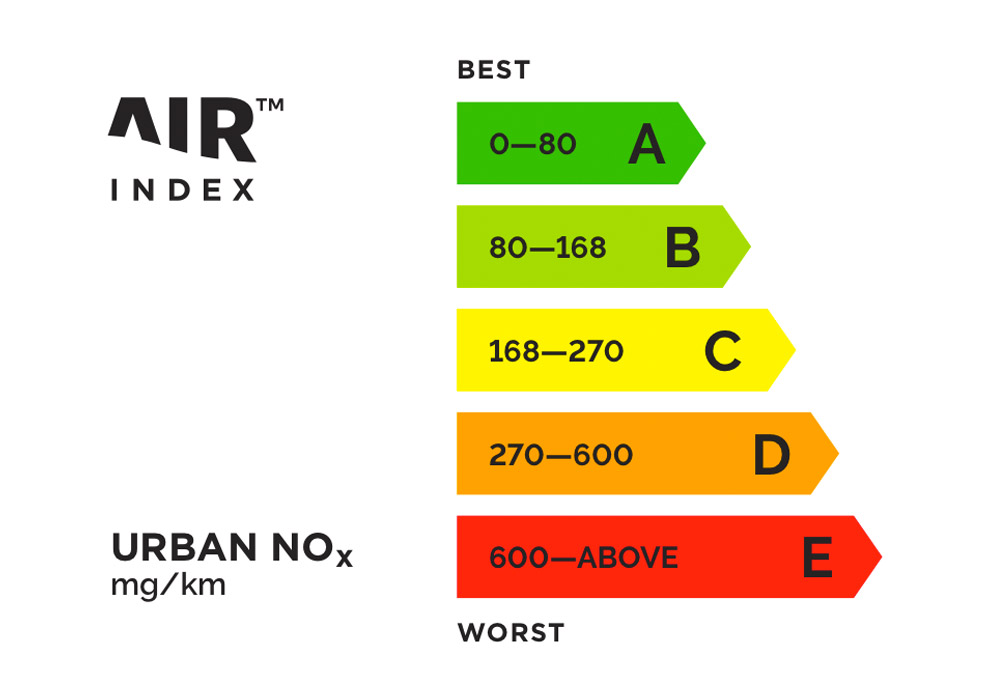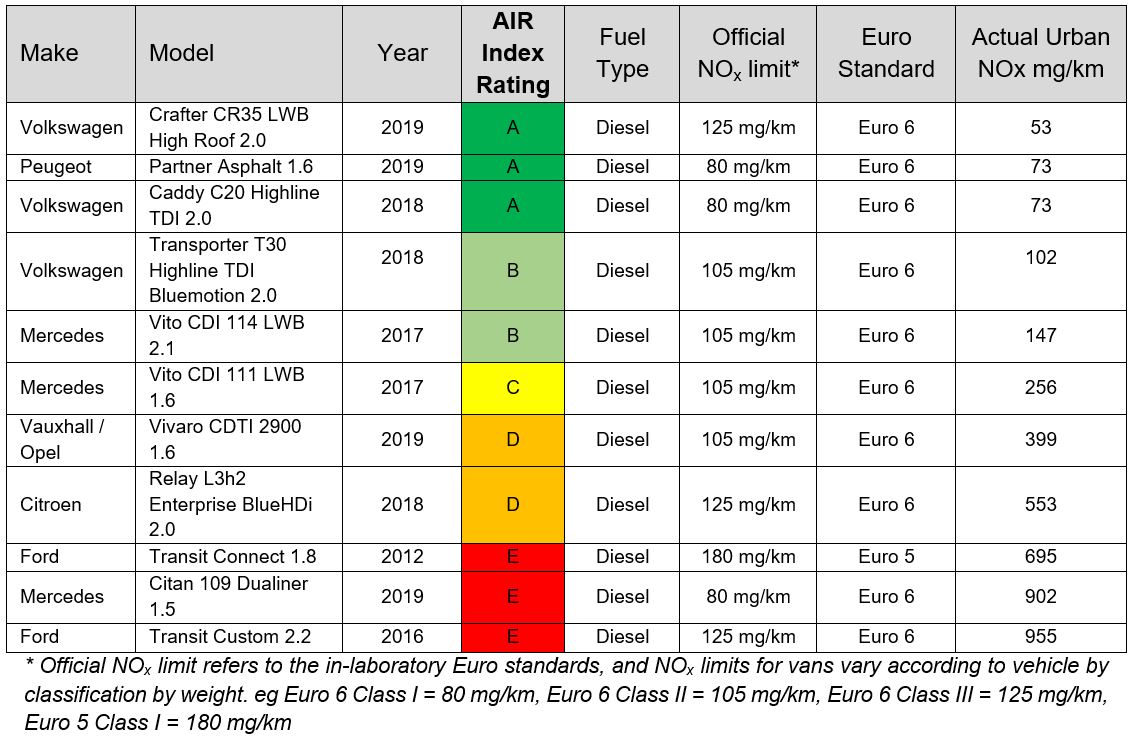REALE EMISSIONSWERTE WERDEN DEN WIEDERAUFBAU DER INDUSTRIE NACH COVID-19 ERMÖGLICHEN UND DABEI DIE LUFTQUALITÄT ERHALTEN UND DEN CO2-AUSSTOẞ VERRINGERN – DE
- Sauberere Fahrzeuge sind jederzeit verfügbar, müssen jedoch von den schmutzigen unterschieden werden
- Die realen Emissionswerte ermöglichen eine Konjunkturerholung für die Automobilindustrie
- Daten zeigen die saubersten Fahrzeuge auf, damit Entscheidungsträger die richtigen Entscheidungen treffen können
- Die Handlungsempfehlung basiert auf realitätsnahen Tests gemäß einem genormten Verfahren
- Offizielle Angaben sind nicht detailliert genug, um die saubersten und effizientesten Fahrzeuge zu identifizieren
- Der AIR Index fügt neue CO2-Werte zu den bestehenden NOX-Daten für Städte hinzu
- Jetzt kostenlos erhältlich auf www.airindex.com
GESPERRT BIS 22. April 00:00 Uhr Britische Sommerzeit (01:00 Uhr MEZ) – Neue Realdaten zu Fahrzeugemissionen ermöglichen ein Wiedererstarken der Automobilindustrie und der globalen Wirtschaft, die von COVID-19 stark geschädigt wurden, bei gleichzeitig geringeren Auswirkungen auf die Luftverschmutzung und den Klimawandel.
Der AIR Index auf airindex.com identifiziert die saubersten Autos, damit Käufer sicher die saubersten Fahrzeuge auswählen können, um so die Automobilindustrie, die von der Pandemie schwer angeschlagen ist, neu zu beleben.
Die frei verfügbare Datenbank ist das Ergebnis rigoroser Straßentests gemäß Abgastest-Norm CWA 17379. Darin werden die realen Stickoxid- (NOx) und Kohlenstoffdioxidemissionen (CO2) aufgeführt – wichtige Schadstoffe, die gemessen werden, um Luftqualität und klimatische Veränderungen zu beurteilen.
Aus der Liste wird ersichtlich, dass saubere und effiziente Fahrzeuge mit niedrigen NOx– und CO2-Emissionen bereits für die Allgemeinheit zur Verfügung stehen.
Heute, am 50. Jahrestag des Earth Day *, ermöglicht der AIR Index ein Wiederaufleben der Industrie, behält jedoch dabei die verbesserte Luftqualität als Ergebnis der globalen Ausgangssperre bei.
Der AIR Index wird von der AIR Alliance (AIR) veröffentlicht und veranschaulicht das Risiko, Fahrzeuge einzig aufgrund offizieller Emissionswerte auszuwählen, die nicht detailliert genug sind, um die saubersten Autos zu identifizieren. Ein Euro-6-Fahrzeug kann sauber oder schmutzig sein. Die offiziellen Daten geben hier nicht genug Klarheit für eine genaue Unterscheidung.
AIR sagt: Wir dürfen die schmutzigen Fahrzeuge nicht mehr in unsere Städte lassen.
Vorhandene Hybridtechnologie kann CO2 erheblich reduzieren, während einige sorgfältig ausgewählte Verbrennungsmotoren inzwischen äußerst niedrige Mengen an Schadstoffemissionen erreichen.
Beide Produkte sind bereits verfügbar, zwingen den Käufer nicht dazu, sein Verhalten zu ändern, und benötigen in Zeiten erheblicher finanzpolitischer Herausforderungen keine staatliche Förderung.
Nick Molden, Mitbegründer von AIR, sagte:
Mit der langsamen Rückkehr zur Normalität nach COVID-19 können sich Gesetzgeber, Hersteller und Käufer auf Fahrzeuge konzentrieren, die die Luftverschmutzung reduzieren, die durch den Wirtschaftsaufschwung wieder ansteigen wird.
Der AIR Index steht allen, einschließlich Automobilherstellern und Entscheidungsträgern, kostenlos zur Verfügung. Wir wollen den Index all denjenigen zur Verfügung stellen, die echte Veränderungen bewirken können.
Da passt es ganz gut, dass uns am Earth Day *, an dem normalerweise Millionen von Menschen das 50. Jubiläum der Kampagnen für einen besseren Klimaschutz gefeiert hätten, eine verlässliche Onlinedatenbank zur Verfügung steht, die zur Senkung der Emissionen auf der ganzen Welt führen kann.
Der AIR bietet Informationen zu den Emissionswerten von hunderten von Fahrzeugen und klassifiziert diese anhand mehrerer Straßentests von A (das beste Fahrzeug) bis E (das schlechteste Fahrzeug).
Als gemeinnützige Organisation ist AIR Alliance unabhängig von der Industrie tätig und kann mit der größten Datenbank an Testergebnissen zeigen, was Fahrzeuge durchgehend bei realen Bedingungen auf der Straße leisten.
Europäische Städte erleben derzeit einen Rückgang von Schadstoffemissionen wie NOx, und CO2, da sich Ausgangssperren erheblich auf die Anzahl der Fahrzeuge auf der Straße auswirken.
Die Herausforderung und die Möglichkeit liegt hier in der Rückkehr zur Massenmobilität, ohne dabei jedoch die gleichen Schadstoffmengen wie vor der Pandemie zu erreichen.
Schlechte Luftqualität steht nachweislich mit einer schnelleren Verbreitung des Coronavirus in Zusammenhang. AIR Alliance wendet sich mit einem pragmatischen Ansatz an Regierungen, Regionen, Städte und die Automobilindustrie, um so noch schneller eine Reduzierung der Emissionen erreichen zu können.
Die Automobilindustrie muss sich nicht auf staatliche Förderung verlassen
Schon jetzt werden Konjunkturprogramme wie Abwrackprämien für die Automobilindustrie gefordert, die Autokäufern einen Anreiz bot, ihr altes emissionsreiches Fahrzeug einzutauschen.
Nick Molden fügt hinzu:
Natürlich gibt es viele Wege, um die Reduzierung von Emissionen anzusprechen. Doch diese Anreize sind äußerst kostspielig, insbesondere in einer Zeit, in der Regierungen und Kunden vor beispiellosen Herausforderungen stehen. Der AIR Index enthält Daten, die einen viel zielgerichteteren Ansatz ermöglichen, und stellt dabei eine kostenlose und schnelle Lösung zur Verfügung. Wir wissen, dass offizielle Emissionswerte nicht ausreichen. Doch mit unseren realitätsnahen Tests und den dazugehörigen Ergebnissen können die richtigen Entscheidungen getroffen werden.
Die Daten zeigen, dass z. B. der Euro-6-Standard nicht ausreicht, wenn Regierungen, Fahrzeughersteller und Gesetzgeber die Klimaprobleme ernsthaft angehen möchten. Der kostenlose AIR Index bietet einen festen Rahmen für sämtliche Strategien in Bezug auf Luftqualität und Klimawandel.
Gute Luftqualität sollte kein Luxusgut sein, sondern etwas, das wir für die Gesundheit der Allgemeinheit anstreben sollten. COVID-19 hat hier die Vorteile von sauberer Luft aufgezeigt. Da sollten wir jetzt weitermachen.
Mit diesen Daten kann sich die Automobilindustrie auf die Fahrzeuge konzentrieren, die heute einen echten Unterschied machen, und ein Umfeld für ein Wiedererstarken in einer Welt schaffen, in der saubere Fahrzeuge die Regel und nicht die Ausnahme sind.
Während batterieelektrische Fahrzeuge weiter auf dem Vormarsch sind, zeigt der AIR Index, dass Hybridfahrzeuge eine kurzfristige Lösung zur Reduzierung von Emissionen darstellen. Auch andere Technologien legen weiter zu, einschließlich der neuesten sauberen und effizienten Euro-6-Benziner und -Diesel. Sie zeigen jedoch auch, dass einige ältere „saubere“ Diesel, die mit Euro 6 konform sind, weiterhin Teil des Problems sind.
Der AIR wurde entwickelt, um Politik, Kontroversen und kommerzielle Konflikte in Bezug auf Fahrzeugemissionen zu umgehen. Seine Mission liegt in der Darlegung von reinen Informationen, die auf der gemeinsamen wissenschaftlichen Erfahrung und dem Fachwissen von weltweit führenden Experten im Bereich der Fahrzeugemissionen, der Luftqualität und dem Gesundheitswesen basieren.
Schließen Sie sich AIR an und helfen Sie dabei, die Luftqualität zu verbessern und dem Klimawandel entgegenzuwirken.
AIR ist ein offenes Bündnis gleichgesinnter Mitglieder. Alle Organisationen, egal ob öffentlich oder privat, die dieselben Werte und Grundsätze teilen, können beitreten.
Führende Wissenschaftlicher haben die Wichtigkeit des AIR Index erkannt und fordern Fahrzeughersteller dazu auf, die Zahlen zu nutzen, um sauberere Fahrzeuge zu bauen.
Dan Carder, Mitglied des Beratenden Wissenschaftsausschusses von AIR und Leiter des Centre for Alternative Fuels, Engines and Emissions (Zentrum für alternative Brennstoffe, Maschinen und Emissionen) der West Virginia University leitete das Team, das die ersten Hinweise auf eine Täuschung von Volkswagen bei US-amerikanischen Emissionstests lieferte und so den Abgasskandal aufdeckte. Er sagte:
Der AIR Index bietet objektive, unabhängige und öffentlich verfügbare Bewertungen der tatsächlichen NOx- und CO2-Werte von Fahrzeugen auf der Straße in städtischen Umgebungen. Dadurch kann er Informationen bieten und mitgestalten, wie Fahrzeuge genutzt werden, um so Umwelteinflüsse des Wirtschaftsaufschwungs einzuschränken.
ENDE
Pressekontakt
Tim Bowdler
tim.bowdler@newspress.co.uk
+44 (0)7434 940162
Besuchen Sie airindex.com. Hier einige Beispiele für beliebte Fahrzeuge, die im AIR Index bewertet werden:
| Modell | NOx Emissionen (mg/km) | Air Index NOx Bewertung | CO2 Emissionen (g/km) | Air Index CO2 Bewertung | Bewertung |
| 2019 Peugeot Partner 1,6 Liter Diesel | 0-80 | 130-180 | Meistverkauftes leichtes Nutzfahrzeug | ||
| 2019 Renault Clio 1,0 Liter Benzin | 0-80 | 130-180 | Beliebter Kleinwagen – neuester Benziner | ||
| 2018 Renault Clio 1,5 Liter Diesel | 80-168 | 95-130 | Beliebter Kleinwagen – Diesel | ||
| 2020 Kia Sportage 1,6 Liter Diesel-Hybrid (MHEV) | 0-80 | 130-180 | Meistverkauftes SUV-Model – Mild-Hybrid | ||
| 2020 Kia Sportage 1,6 Liter Benzin | 0-80 | 130-180 | Meistverkauftes SUV-Model – Benziner | ||
| 2019 Kia Sportage 1,6 Liter Diesel | 0-80 | 130-180 | Meistverkauftes SUV-Model – Diesel | ||
| 2018 VW Passat 2,0 Liter Diesel | 80-168 | 95-130 | Beliebte Familienlimousine – Diesel |
Hinweise an die Redakteure:
AIR führt kontinuierlich Testprogramme für Fahrzeuge durch und dem AIR Index werden regelmäßig weitere Daten hinzugefügt.
Inspiriert wurde der AIR Index von NCAP, dem unabhängigen Programm zur Sicherheitsbewertung von Neuwagen, das in den 1970er Jahren in den USA entwickelt und weltweit zum Industriestandard wurde. Das Programm zog Autohersteller für ihre Sicherheitsleistung zur Rechenschaft und sorgte so für eine freiwillige Annahme von Technologien, die zu sicheren Fahrzeugen führten.
AIR testet für den AIR Index mindestens zwei verschiedene Fahrzeuge eines jeden derzeit verfügbaren Modells. Der Test wird dabei mit einem wissenschaftlich fundierten Programm auf der Straße durchgeführt. Anschließend werden dann die Emissionswerte für eine Bewertung im AIR Index zusammengestellt.
Für die Beurteilung eines jeden Fahrzeugs wird das neueste Verfahren gemäß CWA 17379 verwendet. Dieses wurde auf europäischer Ebene entwickelt, um die Emissionswerte unterschiedlicher Fahrzeuge mit Hilfe eines mobilen Emissionsmessgeräts (PEMS) fair vergleichen zu können und so sicherzustellen, dass die Technologie zuverlässige Emissionsdaten liefert, die transparent und für alle verfügbar sind.
* Der erste Earth Day wurde am 22. April 1970 veranstaltet und führte 20 Millionen Amerikaner auf die Straßen und Universitätsgelände hunderter Städte, um gegen die Ölkatastrophe an der Küste Santa Barbaras zu protestieren. Der erste Earth Day wird als Start der Kampagnen für die Umwelt angesehen und stellt heute die größte Bürgerinitiative der Welt dar.



